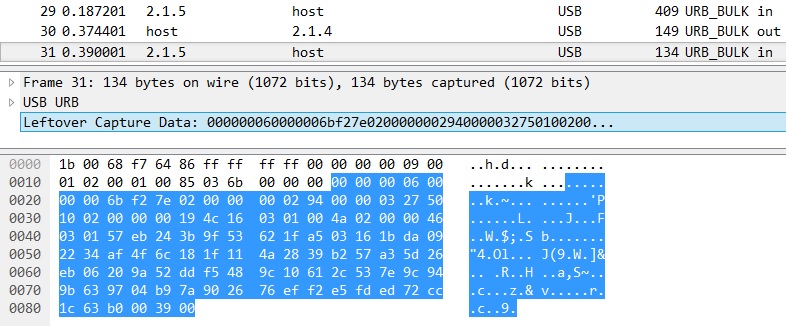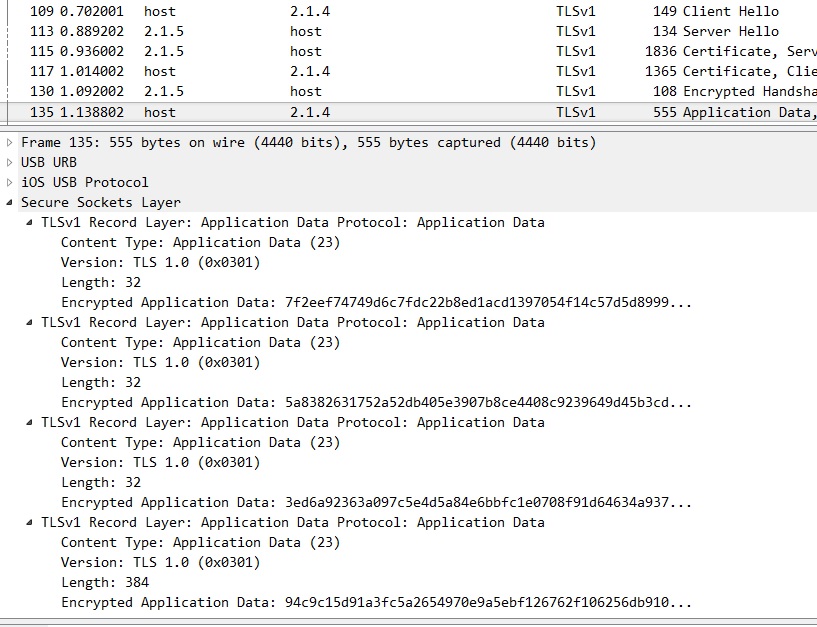Hello everyone I used to decrypt HTTPS session by providing "Client Random" and "Master Secret" into wireshark. Recently, I need to decrypt SSL session which is created in USB communication. USB header is parsed by wireshark. But some byte and SSL header are not parsed by wireshark. it just show me payload as "Leftover Capture Data"
So I decide to use Lua script for parsing "Leftover Capture Data" as 28-byte unknown protocol and SSL. My Lua script is This script can parse SSL header successfully I also extract Client Random and Master secret. And I put it in the Preferences -> Protocols -> SSL -> (Pre)master-Secret Log file Even though I give key file for decrypting, I cannot get decrypted payload of SSL.
Is there any tips for decrypting ssl session using Lua ssl dissector? Thank you! asked 03 Oct ‘16, 23:05 yobob edited 04 Oct ‘16, 02:13 showing 5 of 8 show 3 more comments |
One Answer:
For SSL/TLS decryption, a client and server side must be known identified since both sides contribute to the session secret via the nonces in their Hello messages (Client Random and Server Random). This client/server is determined automatically when using UDP/TCP, but for other protocols you (as the parent layer) must provide this information. On the USB level, data packets go from the host to the device (for an OUT endpoint) or from the device to the host (for an IN endpoint). These endpoint numbers are not necessarily the same and in that case Wireshark sees two separate conversations: Thus the SSL dissector is unable to understand that these two data streams are paired. According to the WSLUA documentation, fields like Note that these properties form a "conversation" (see
To ensure that the old, USB-specific conversations are not accidentally matched, chose source/destination addresses that are definitely different or pick any other port type. The SSL dissector currently does not check the port type, so if you for example have HTTP, you could set a conversation like this (swap roles accordingly):
(If you pick If this still does not give the expected result, enable the SSL debug log. For example, if the log shows two different "ssl_session" pointer addresses, then you know that the conversation is messed up. answered 07 Oct '16, 15:57 Lekensteyn edited 08 Oct '16, 08:21 Thank you for your comment. As you told, I should have set pinfo.src_port and pinfo.dst_port to decrypt packets. I could get decrypted packets after that. thank you again, Lekensteyn (11 Oct '16, 21:55) yobob @yobob If your question is answered, consider pressing accepting this answer by pressing the tick on the left. Thanks! (16 Oct '16, 13:33) Lekensteyn |



Wow for the idea. However, I’m afraid that to get a real solution, you’ll need to file a bug (category enhancement), because currently, part of ssl decryption configuration is to tell the ssl dissector what other dissector to use to handle the decrypted data, and the fields used as index to the table are IP address and tcp port.
As a temporary workaround I could imagine to use tshark to extract the payload from the URBs (
-T fields -e usb.addr -e usb.capdata) and feed its output to a script which would provide fake TCP headers to the data - which, however, would also not be an easy task as you would have to properly imitate at least the seq and ack numbers so that the tcp dissector would be happy. The script could output a simple hexdump format which you would then feed to text2pcap or import it to Wireshark usingFile -> Import from Hex Dump.An idea which didn’t come to my mind instantly would be to use Lua to create these fake TCP and IP headers during dissection (you’d have to create a new tvb containing the fake headers followed by the data extracted from the URB), and you would have to save the values for the headers as each frame may be dissected multiple times - they are dissected in sequence only once during loading or capture of the file.
Would it be easier to create UDP headers, and then you’d have DTLS?
I’m not sure. DTLS uses its own sequence numbering to ensure that the TLS PDUs are properly ordered, plus it uses an indicator of cipher state changes, so instead of generating TCP’s
seqandackvalues outside the original encrypted data, you’d have to take care about DTLS’ssequence_numberandepochin the middle of the encrypted data.Ah, I’ve only looked at DTLS ever so briefly and obviously didn’t understand the intricacies.
Thank you for your comments. I will try to replace USB header to TCP dummy header. By the way, the Lua ssl dissector is different with the default ssl dissector of wireshark?
There is no such thing like “Lua SSL dissector” (unless you have written your own one but in such case the question would make no sense, right?). Lua dissectors can invoke C dissectors and vice versa.
Replacing USB header with a TCP dummy header is not exactly what I had in mind. A dissector normally acts on the actual bytes of a captured frame and from its point of view, these bytes are read-only. But any dissector can create additional bytes of data and ask a higher layer dissector to handle them as if they were part of the captured frame.
So what I’ve recommended was to create the IP and TCP header as a byte array, concatenate to it the payload extracted from the URB, and use the bytearray:tvb function to create a new tvb from it and call the existing IP dissector, giving it your new tvb as a target.
The IP header must be there too because the SSL dissector uses both IP address and port as keys to the table choosing the right dissector for the decrypted payload, and because you have to specify even
data(i.e. no dissection, just display of the contents in hexadecimal) explicitly.Myself I would use IP address
10.0.0.1to represent the USB host and10.0.bus.deviceto represent the USB endpoint, so an URB fromhostto2.1.4would have10.0.0.1as IP source and10.0.2.1as IP destination, and vice versa. The server side TCP port should be set to a value to which no other dissector of TCP payload is linked by default, something like33333, and you may link thessldissector to that TCP port already in your initialization code:The client side port should be in the range from
40000up.As already written, the TCP header cannot be totally dummy because otherwise the TCP dissector would not invoke the higher layer dissector (in our case, the SSL one). I believe, though, that it is not necessary to simulate the SYN, SYN+ACK, ACK session establishment sequence.
One more point, as USB by nature uses distinct data endpoints for in and out directions even if they form up a bi-directional logical channel, the
ssldissector would not even know that the messages to one endpoint and the messages from the other one belong to the same conversation. To let thessldissector handle the conversation properly, the fake IP and TCP headers must use the same pair of IP:port tuples, properly oriented as source and destination depending on the URB direction. What my workaround suggestion ignores is that the USB device may theoretically use several pairs of data endpoints and that in such case, the only way to determine which IN endpoint works in tandem with which OUT endpoint would be to analyse the descriptors.For the record, of course the clean way would be to file an enhancement “bug” asking for the
ssldissector to understand USB conversations directly, without the need to create fake IP and TCP headers, as stated in my first reaction. But that would require some investigation into the issue above, i.e. to verify and describe a method of determination which endpoints form up a bi-directional logical channel.